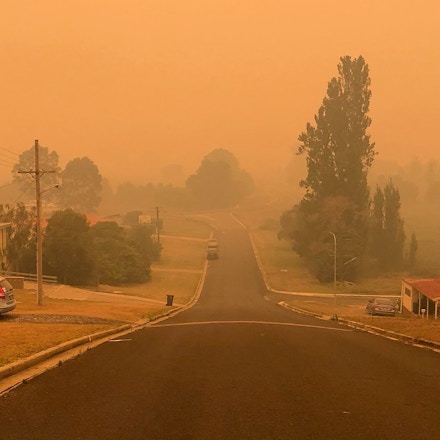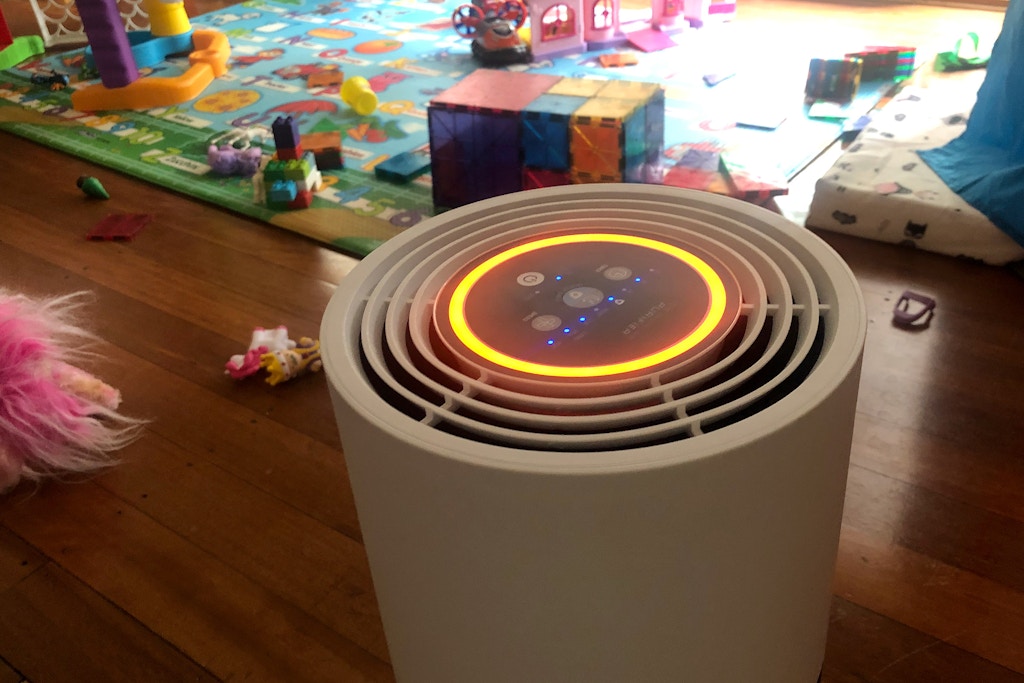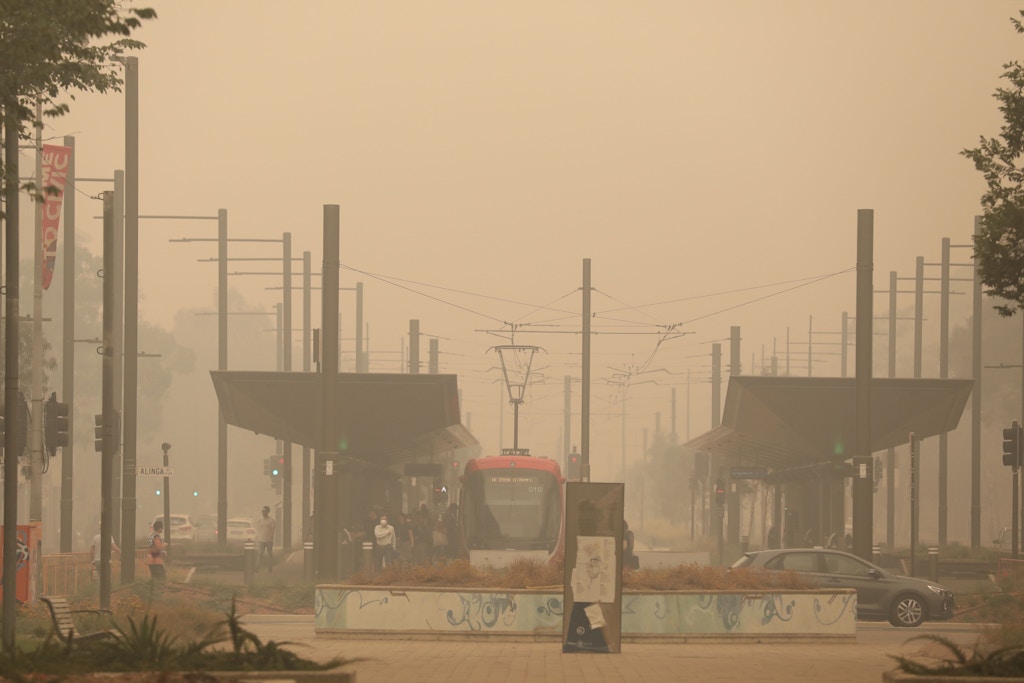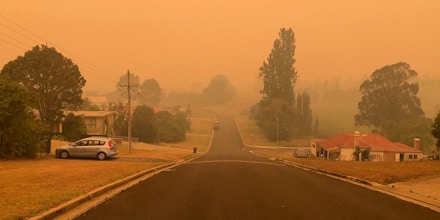The Search for Clean Air Amid Australia’s Smoky Fires
Eric Byler January 15 2020
THE BACKGROUND DIN of sadness drones loudest when the air in Canberra is safe to breathe. The first two weeks of 2020 have been a pendulum swing between fighting and fleeing from smoke, and a near-perfect likeness of the idyllic life we had before fire season. With the sadness, there is also relief on the good days and hope that the worst is over. And then the city is blanketed in smoke again. We see it. We smell it. This fog of death, loss, terror, and suffering stretching for miles in every direction. How long will it stay this time? And beneath it all, another uncertainty: What is all this smoke doing to my children?
To measure the health risks of air pollution, the Australian Capital Territory (ACT) uses an Air Quality Index (AQI) based on measurements of the concentration of particulate matter. An AQI of 67 to 99 is considered “fair,” 100 to 149 is “poor,” 150 to 200 is “very poor,” and 200+ is “hazardous.”

Related
The Banality of Apocalypse: Escaping, With “Paw Patrol” and Daniel Tiger, From the Australian Fires
The AQI hit 4,650 on New Year’s Day in Canberra, the capital city of Australia. That was the day that fires chased us home from the beach. When we got to our house, I stuffed paper towels in the crevices of the doors, but it was wasn’t enough. That night, I didn’t sleep. It was sweltering. And every breath tasted like sticky tar.
It got better for a few days. Then on January 4, soaring temperatures and high winds meant another stretch of losing battles for our firefighters. In came the smoke, and the AQI reached 4,400 on January 5.
The workers who cooked our fish and chips were wearing breathing masks. We’d left ours in the car.
Our kindly landlord had fitted all of our doors with foam sealing, and he’d told us of a DIY air-filtration technique: hanging wet towels over fans. But our house could not withstand the onslaught. We fled. Old Parliament House and the science museum, our favorite places to take Audrey, age 4, and Julian, age 2, on bad weather days, had shut their doors due to air quality. As I drove past new Parliament House, I asked my wife, Ariane, to shoot video on her phone. She could barely see it through the smoke.
We ended up at Canberra Outlet Centre, an indoor mall that looks exactly like you would imagine it. It was a lot better than outside, but the smoke had permeated every inch of it. More than half of the stores had closed. We fed the children and left. The workers who cooked their fish and chips were wearing breathing masks. We’d left ours in the car.
From there, we drove to the Crowne Plaza Hotel. Its soaring lobby, too, was filled with smoke. I realized that any building with a door would suffer the same fate, especially hotels and malls with doors that are used by many. But our room on the second floor smelled clean. We’d found our haven for the night.
The air was still bad the next morning. It was Monday. The Department of Home Affairs, which is responsible for emergency management, had told staff to stay home due to the hazardous air. The National Gallery of Australia sealed its doors, not only to protect staff and patrons, but also the priceless paintings on display.
When we got home, the house smelled OK. Maybe I was just used to it. I put a TV show on for my daughter. My son began playing with the toys from which he’d briefly been separated. The towels I’d hung over the fans were of course dry by now. The blades of the fans were coated with fine, black powder. The eastern-facing doors had been rammed by high winds overnight. When I opened the main entrance, dirt and debris fell to the floor.
A few days later, our air purifier was delivered. As glad as I was to have it, my heart sank when the ring circling the control panel showed red. This meant our house’s air quality was “poor.” But it smelled fine.
When I related this to our landlord, he said, “Yeah, when it’s really thick like that, those fine particles find a way in no matter what you do.”
The fine particles, known as PM2.5, contain toxins linked to respiratory ailments, cancer, and heart disease. They are small enough to penetrate the blood system and the body’s tissues. They have no odor, and health experts say they are harmful in particular to the infirm, the elderly, and children.
An elderly woman had died from respiratory distress upon setting foot on the smoke-filled tarmac at the Canberra airport. An asthmatic teenager had died after bushfire smoke inundated Glenn Innes, New South Wales.
Air purifiers remain sold out everywhere in town, but my wife had found one online. Now, our little air-cleaning robot was puffing up a storm. Before long, the light turned from red to orange (fair). Then yellow (good). Then blue (very good).
With a blue ring of light atop its knee-high, cylindrical frame, the air purifier reminded me of R2D2, who saved Luke Skywalker’s life countless times. We’ve turned the corner, I thought. R2 is here. From then on, if I saw blue, we were winning. Any other color, we were losing, or at least that became my view and, soon, my preoccupation.

Eric Byler’s air purifier glows with an orange light, which signifies “fair” air quality on Jan. 11 2020. Photo: Eric Byler for The Intercept
“IT’S FUNNY the things you get used to,” I said.
“Yeah,” said Bill, a baseball coach and longtime player for the Ainslie Gungahlin Bears. We were on the ball field at Madura Oval, looking at our phones to check the air quality before a round of batting practice.
“What app do you use?”
“It’s called Air Matters.”
“Mine is CanberraAir,” I said.
I downloaded Air Matters and later found that it allowed me to monitor air quality in other cities in Australia and around the world on a single dashboard. For the next few days, I periodically compared Canberra’s air quality to that of the notoriously polluted city of Delhi, India. Ours usually was worse, and not by a little.
At the National Arboretum, I befriended a man named Chris, who, like me, was stupid enough to accompany his children through narrow tunnels made of rope that climb steeply up to a corkscrew-shaped slide. It was a good-air day.
Chris told me that he had extended family members now living with him because they had lost their homes, or abandoned them hoping that they can still be saved. To rescue stranded relatives, he’d driven four hours through some of the most-affected, coastal areas of New South Wales in a pickup truck loaded with fuel containers.
“It’s like this only once every 20 years,” he said.
It had been 17 years since bushfires engulfed the mountains on which we stood. On January 18, 2003, three fires combined into one and roared into Canberra’s suburbs, destroying nearly 500 homes, killing four people and injuring 470. Fire experts said it was the fastest-moving bushfire ever documented, advancing 20 kilometers per hour on a panicked and unprepared city thanks to 80 kilometer-per-hour winds.
When the kids were asleep, I positioned R2 in the hallway, equidistant from their bedroom doors. I let it run for hours. I re-taped the doors and taped up some windows I hadn’t done before.
January 10, 2020 was a good-air day. Our day care center was open, and, even better, the air was safe enough for the children to play outside. As normal as things looked, we couldn’t forget that 150 bushfires were still burning and that the weekend forecast included very hot temperatures and swift wind currents. And of course, we followed the news reports. Twenty-seven people had lost their lives, all the lost homes, the wildlife, the farm animals. What can I say? It’s mind-numbing.
“Blue!” I announced as we entered the house after bringing the kids home from the pool. We’d left just as the smoke was rolling in.
When the kids were asleep, I positioned R2 in the hallway, equidistant from their bedroom doors. I let it run for hours, then moved it to other parts of the house, just briefly, to check the air quality. It was yellow in places: “good” as opposed to “very good.” I re-taped the doors and taped up some windows that I hadn’t done before.
Ariane awakened me at 9:30 a.m. She needed me to watch the kids as she was off to the farmers market. I checked my phone and said, “Are you sure? It’s 172 [unhealthy].”
“Yeah, it’s OK, I won’t be long.”
I noticed that R2 was still in the hall and had been switched off, perhaps by my son who loves to push buttons.
I moved it into the room where the kids were: the TV room, which is the largest in the house.
The air quality indicator glowed red.
I texted Ariane: “Air purifier has had a red light for the last 20 minutes. I plugged it in behind where the kids are sitting.”
As the air quality outside worsened and the red light persisted, I got more and more anxious. This was the first time the AQI had reached “very unhealthy” since R2 had arrived. I had already closed two doors: the one to the hallway and the one to the kitchen. The other egress was a wide entryway that had no door. It led to the dining room and the only door we currently use to exit the house.
I began blocking the dining room’s entryway with anything I could find. For the bottom third, I used a quilted blanket draped over two chairs. The top two-thirds: a mosaic of the children’s artwork, including a giant treasure map that Audrey felt was too important for non-treasure-hunting use.
“I need to keep it there to help make the air better,” I explained.
R2 was reading orange: “fair.”
The light turned yellow when I was 95 percent finished with my wall. Audrey said, “How will we eat?”
“We can get to the dining room through the kitchen,” I said. The light soon turned blue.
“What is all this?” Ariane said when she came home from the farmers market.
“It was the only way I could turn things around. It was stuck on red.”
“Did you have to use the kids’ artwork?”
“And some of it is not the right way,” Audrey said, pointing to a drawing of hers that was turned on its side. She’d objected and I’d refused to fix it.
“But Audrey, I think your artwork looks beautiful in this context, while also showing its utility,” I said.
“You can just get a mattress bag,” Ariane said. “It will work a lot better.”
“Guess what, kids? We’re having a picnic!” I said. We’d be eating in the parlor with the kitchen door closed.
By dinnertime, the AQI had reached 550. Worse than Delhi. Ariane wanted us to eat like a normal family at the dining room table.
“It’s right by the door, the air is bad there,” I said.
“Well, put the thing in there for 10 minutes,” she said, referring to R2.
I did, but R2 did not move off red.
“Guess what, kids? We’re having a picnic!” I said. We’d be eating in the parlor with the kitchen door closed.
When I powered up R2 in the parlor, it was red there too. It had only been away for 10 minutes.
As the children ate and the air quality gradually improved, Ariane and I reopened the discussion we’d had about flying to Brisbane for the weekend. It would cost us $2,000, and I didn’t think it was worth the expense.
After dinner, we piled everyone into the master bedroom with R2.
“Oh shit,” I said, when I switched it on. Red.
But that improved over the next 20 minutes, during which I left to borrow a ladder so I could tape plastic over an inward-blowing fan on the ceiling above the toilet. I also rewet the towels and draped them over the fans. When I returned to the bedroom, Ariane informed me that Audrey had repeated my “Oh shit” thrice.

A light-rail station is shrouded in bushfire smoke in Canberra, Australia, on Jan. 5, 2020.
Photo: Chu Chen/Xinhua via Getty Images
MONDAY WAS ANOTHER bad-air day. During a five-minute drive to interview climate scientist William Steffen, I thought briefly about canceling. The AQI was approaching 400 and I’d just dropped off my children with a relative who hadn’t sealed up her house. Sometimes I feel like I’m being a paranoid alarmist — other times, I feel like I’m failing to protect my family from danger.
“For the common good,” I thought to myself and kept driving.
The day before, Australian Prime Minister Scott Morrison had made big news by publicly recognizing the reality of climate change. Professor Steffen was not impressed. “Acknowledgment needs to be followed up with action, of course. And we’ll see what happens there. I’m not optimistic.”
He said Australia needs to increase its targets for the reduction of carbon dioxide emissions, and take steps to meet them. Since 1997, seven prime ministers had suffered defeats after trying to do that. Australia had signed the 2016 Paris Agreement, promising to reduce emissions by 26 percent by 2030. But emissions have gone up each year since then.
I asked Steffen if he embraced the sentiment expressed by novelist Richard Flanagan in his op-ed, “Australia Is Committing Climate Suicide.”
Steffen agreed with Flanagan’s condemnation of their government’s failure on climate policy — and said that Australia might be “one of the first countries that really comes apart as the climate shifts.” But the word “suicide,” he said, was just a way of saying things have gotten out of hand.
I quoted the prime minister, who had said Australia is responsible for only 1.23 percent of global emissions, and that if Australia shut down its fossil fuel industries tomorrow, China would make up for that in about nine days.
“It’s a collective action problem,” he said. “Just like in any civilized country, you have an income tax. So, if you look at my share of the Australian revenue, my income tax that I pay, it’s tiny. So based on the prime minister’s argument, I should write to the Australian Tax Authority and say I want to no longer pay my income tax. It’s too small to matter.”
I laughed.
“We have one planet, one climate, and we’re one species,” he said. “We’ve got to get over this stupid nationalistic crap that’s out there stopping us from taking action,” he said.
“It’s really too late to prevent a 2-degree [Celsius] increase?” I asked, referring to global temperature averages.
“No, I think we can just make 2. It’s too late to prevent 1.5.”
My next question assumed that a 2-degree increase would bring bushfires twice as bad as what we have now, with a 1.1-degree increase. Steffen interrupted. “I think it’s going to be three or four times as bad.” He explained that regions with climates similar to Australia’s will be dealing with worsening fires, while other regions will suffer from hurricanes, cyclones, and floods of increasing severity.
“Wherever you are in the world, the climate you are used to is changing.”
As I packed up my video gear, we chatted about the smoke. Steffen said he had gone out jogging that morning, when the AQI was 150. “But once it was up to 350, 400, when I took the dog for a walk, I had my mask.”
“Why is it better in the early morning?” I asked.
“Typically, because it’s calmer. So the wind hasn’t come in yet. And the fires aren’t immediately at our doorstep, so most of the smoke is being blown in from some distance.”
He said the AQI is generally at its lowest around dawn, “unless there is a front and it just blows through the night and the day, so you just have to check it all the time.”
Ariane sent me two text messages: “Air at hazard level now. Better to come home.” Then: “Can you bring Audrey home.”
The AQI had been 78 (moderate) the morning before. We were at a birthday party for a family friend, outdoors, at a tennis club across the street from our house. For the first time, little Julian understood the drill. When he saw that candles were being placed on the cake, he said, “Sing ‘Happy Birthday.’” He and I practiced quietly a few times, and when the real thing came, he landed most of the song in tune.
The CanberraAir app revised its figures in the late morning, and it had only gone up a little, still in the moderate range. I jumped into a doubles tennis match.
Ariane took Julian home for his nap, while Audrey sat on a bench next to the court eating popcorn and watching Netflix on my phone. Shortly after noon, Ariane sent me two text messages:
Air at hazard level now. Better to come home.
Can you bring Audrey home.
I didn’t see them, so Ariane came back for Audrey. As I said my goodbyes, I offered our house to the remaining guests, including three grandparents and four children. No one came. The grandmothers each thanked me but said they’d be going soon anyway. The grandfather grabbed a racquet and took my place on the court.
When I got home, I did not like the state of things. Ariane and Audrey were in the parlor with R2, who was orange. Julian was in the master bedroom still napping.
“How’s the air for Julian?” I asked.
I moved R2 into the bedroom in order to check. Orange there as well. “We’re going back to submarine mode,” I announced. With the constant creep of smoke-poisoned air, there were some rooms we couldn’t afford to protect.
A second air purifier will be delivered to our home soon.
RELATED

The Banality of Apocalypse: Escaping, With “Paw Patrol” and Daniel Tiger, From the Australian Fires

Video Diary of Apocalypse: A Family Flees Australia’s Fires
No comments:
Post a Comment